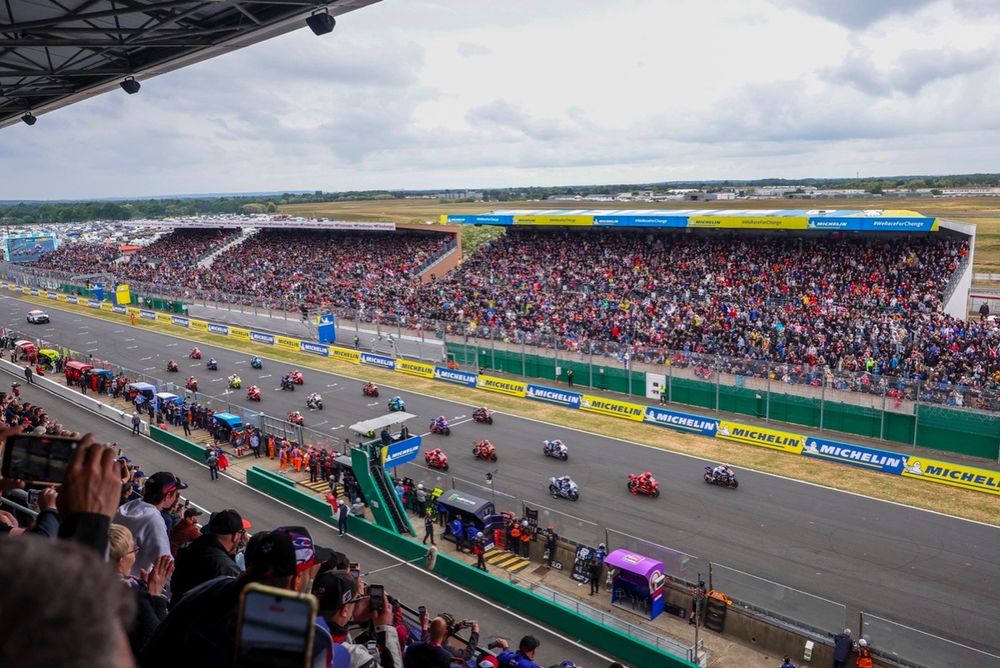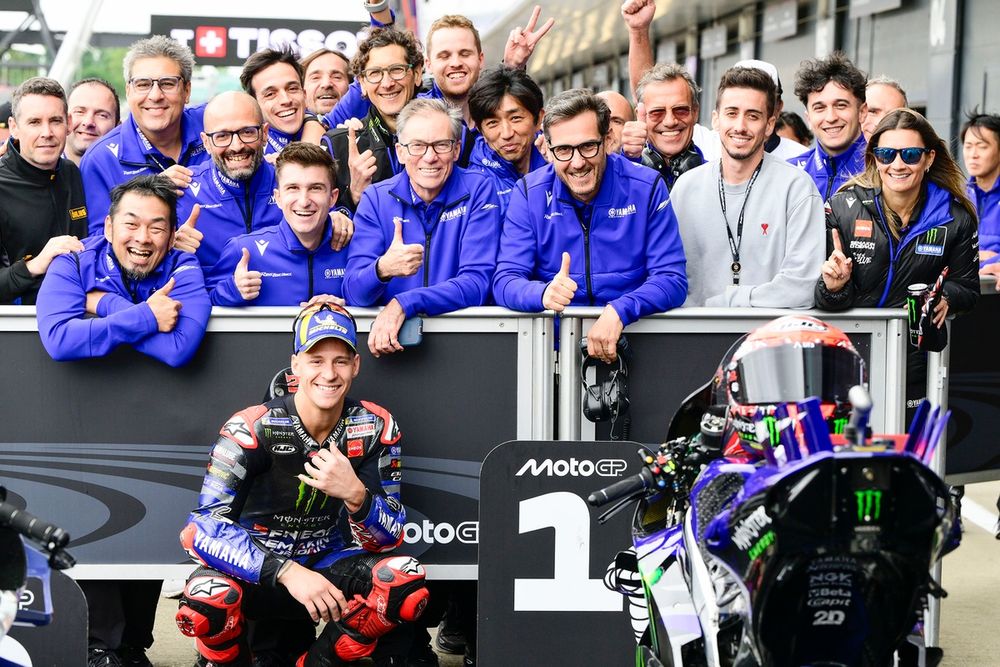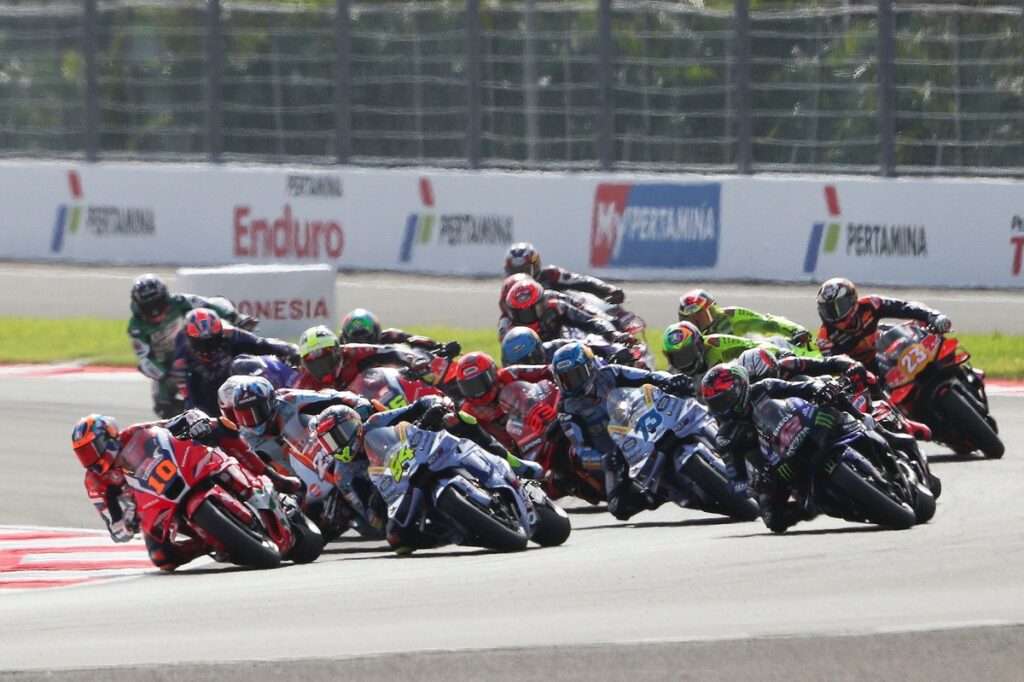The current era of MotoGP is a far cry from the mid-to-late 2010s, when the three-way rivalry between Marc Marquez, Jorge Lorenzo and Valentino Rossi defined the championship.
The emphasis on aerodynamics, ride-height devices and stricter tyre pressure rules in the last few years fundamentally changed the way riders race against each other in the world’s premier motorcycle racing championship.
And while Ducati is dominating the championship, the strides Honda and Yamaha have made this year have actually brought the field closer.
At last month’s Japanese Grand Prix, Joan Mir scored the factory Honda team’s first podium finish in two years after finishing third behind Ducati duo Francesco Bagnaia and Marc Marquez.
For many, this was the clearest sign yet that Honda’s development direction is finally paying off. But Mir’s team-mate Luca Marini was quick to stress the importance of the Spaniard’s front-row qualifying performance, which set the tone for the rest of his weekend.
“Every bike is able to fight with a good qualifying,” he said. “Even [Fabio] Quartararo made a fantastic race starting from pole position, even if the potential of the [Yamaha] package is not that [strong].
“Now with the bike that we have, if you start on the first row, it’s a very easy race compared to starting in the back and recovering, even when you have a good pace, because it’s very difficult to overtake.
“Now, every bike is super competitive, and the qualifying lap is very important. We try to do it well every time, and Joan did it very well in Japan.”
Importance of Friday practice
Luca Marini, Honda HRC
Photo by: Gold and Goose Photography / LAT Images / via Getty Images
Since the middle of the 2023 season, MotoGP has placed even more importance on single-lap speed. As part of the revised format, the fastest 10 riders in the main practice session on Friday automatically earn a spot inside Q2. This is a massive departure from the previous structure, where combined times were taken after Saturday’s FP3 session (now renamed FP2) to determine the Q1/Q2 order.
This has effectively turned Friday afternoon practice into a mini-qualifying session, increasing the intensity of a schedule already made complicated by the addition of sprint races. Fail to make the top 10 on Friday and the entire weekend becomes an uphill battle. Secure a Q2 spot and you’re guaranteed a position in the first four rows of the grid.
“It’s changing our approach to the weekend a lot,” said Marini. “Now we are pushing on the very limit of the practice to stay in the top 10, because this can change your weekend.
“For the moment, it’s like this. If you don’t have the pace, but if you start in the front, you can achieve a very good result. If you have the best pace of the grid, but if you start 12th, I think the race will be tough.”
2025 MotoGP statistics
|
Wins from outside the front row |
4 |
|
Podiums from outside the top two rows |
11 (in 10 races) |
|
Lowest grid position for a win |
10th (Bezzecchi, British GP) |
|
Lowest grid position for a podium |
11th (Bagnaia, Qatar; Zarco, France) |
Is qualifying pace really more important than race pace now? The data from 2025 supports both sides of the argument.
Out of the 18 grands prix held so far, 11 riders (across 10 races) have finished on the podium after starting outside the front two rows of the grid. That suggests strong race pace can still make a difference at around half the circuits on the calendar.

Start Grid
Photo by: Dorna
But, it’s also important to highlight that no rider has finished on the podium after starting 12th or lower on the grid. This means that if someone fails to make it into Q2 on Saturday morning, then their chances of finishing on the podium are as good as over.
The most impressive charge of 2025 came from Bagnaia, who darted to third place in Qatar after a crash in qualifying left him 11th on the grid. Johann Zarco also started from 11th when he won the rain-hit French GP, but his incredible victory was aided by the unusual circumstances at Le Mans.
The next-lowest position from which anyone won a race this season is 10th, as Marco Bezzecchi produced a masterclass in tyre management to win the British Grand Prix for Aprilia.
Of course, there are usually caveats to consider, including Ducati’s exceptional record in qualifying this season. This means that most Ducati riders have rarely started the race out of position.
Qualifying isn’t everything – yet
It’s important to note that Marini’s argument reflected the perspective of Japanese brands Honda and Yamaha, who have a better chance of competing against the European brands when they start higher up the grid.
According to him, it’s difficult for Honda riders to challenge the likes of KTM and Aprilia when they qualify in the lower half of the grid. But if a Honda is on the front row, as was the case in Motegi with Mir, even world champion Marquez has to get aggressive to pass it on track.

Polesitter Fabio Quartararo, Yamaha Factory Racing
Photo by: Gold and Goose Photography / LAT Images / via Getty Images
That is a completely fair argument, and is backed up by the results both Mir and Marini have achieved since the summer break on the upgraded RC213V.
But as Quartararo’s season shows, qualifying alone doesn’t guarantee success. Despite his brilliance in qualifying, the Frenchman was only able to convert one of his four pole positions into one podium this year. Even if we factor in his mechanical-induced retirement from the lead in the British GP, his conversion rate is still pretty low.
Ultimately, a bike still needs to be competitive in race trim if it is to hang on to its starting position. With the M1, even a rider as gifted as Quartararo has struggled to overcome its limitations once the lights go out.
So, while one may say MotoGP has shifted towards a ‘qualifying-first’ era, there is still a lot to play for in sprints and Sunday races.
We want to hear from you!
Let us know what you would like to see from us in the future.
Take our survey
– The Autosport.com Team
Read the full article here

